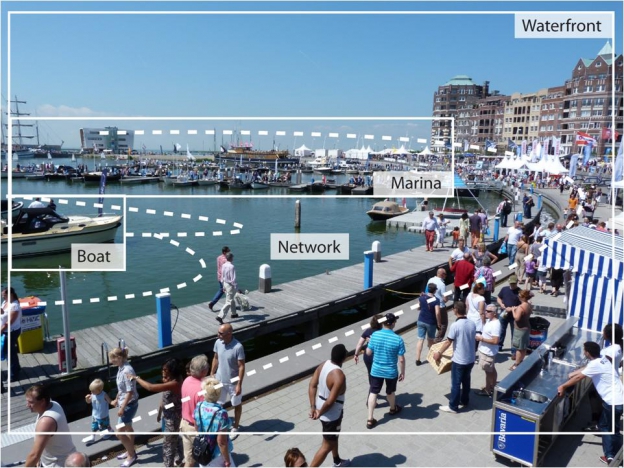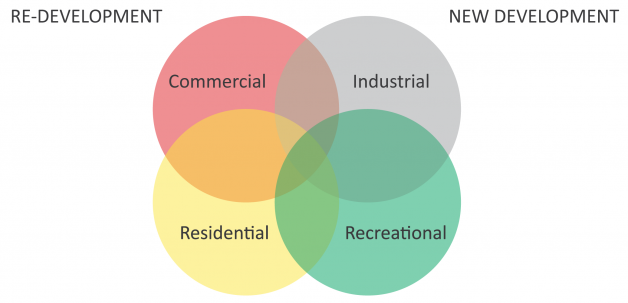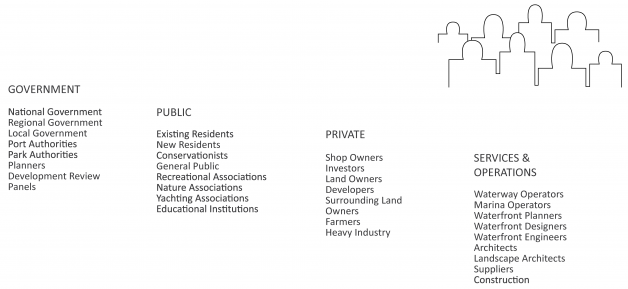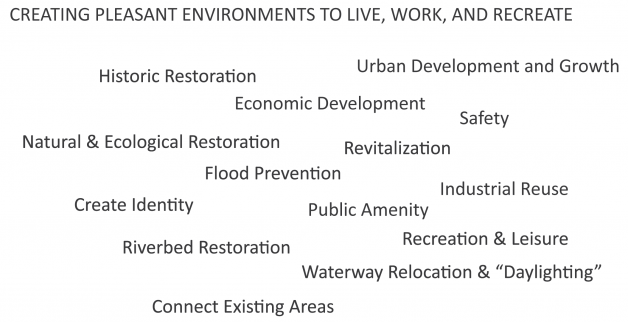In this section we encourage people to think as broadly as possible about waterfronts – the edge between water and land – and the potential for living, working, and recreating waterfronts. If you have a particular project in mind, please contact us, check out Waterfronts NL's services, or visit our company profiles to learn more about each company's unique approach.

A recent study by Waterfronts NL founding member WA Yachting Consultants found that the City of Amsterdam (population 1 million) has around 18,000 boats -- four times the boat population of China!
How is this possible? Because a boat needs a place to moor -- in a marina, or along a dock, or anchored at sea. And people on the boat will want to go somewhere on land and people on land will want to connect with the water -- this edge between the water and land is the waterfront, which is often filled with marinas, ecological reserves, lively public spaces, shops, industrial ports, and other water-land activities. While one successful waterfront may be enough to attract a small fleet of boats, the most successful boating areas include a network of attractions accessible by sea, and often connected by land transportation, to make a region a boating destination.
You cannot simply have a boat without the infrastructure and activities needed to support it.

Waterfront development can include any combination of different land uses, and waterfront projects can be new projects or re-developments of existing waterfronts into new places. Some waterfront projects focus on industrial uses, such as industrial ports, and others focus on more recreational and tourism-oriented uses. It's important that a diversity of uses can occur along a waterfront, bringing in as many interests as possible to the waterfront, but it's not necessary that a diversity of uses occurs within each project. For example, due to environmental, public safety and security reasons, it may not be appropriate to locate a public park and residential neighbourhood within the same zone as an industrial port.
Each site has its own environmental, political, resource, climatic, and social contexts -- there is no one solution for all. A trained eye, an understanding of local and regional contexts, and years of experience can help determine different options for mixes of land uses, and the impacts they will have on their context.

A wide variety of people and interests are involved in waterfront development, and understanding these interests and planning for them can only help in the successful implementation of a waterfront project. Involving stakeholders in development projects is becoming a global norm, and not just in democratic countries. Clients all over the world are beginning to understand the value of involving people affected by their development in the development process. Understanding a broader context of the people affected and involved in waterfront development can speed up the approval process, can create mutual benefits, and can prevent future conflicts.

There are many important reasons to develop new, and re-develop existing, waterfronts. Waterfronts are places to live, places to work, and places we enjoy recreating. People all over the world have been living with water for millenia, as a source of food, transportation, and harmony.
In recent years, managing water has become a major political and social topic because of climatic events that have caught a lot of media attention. People have been questioning whether waterfront property should be promoted as a place to live, or whether giant walls should be built to protect people from advancing water levels anticipated by climate change experts.
The Dutch have been managing water for centuries. Much of The Netherlands is located below sea level, and the Dutch have learned from centuries of floods and fluctuating sea levels how to prevent disasters and how to live with water in changing global climates.

Land and water development can be complex processes, with a lot of regional variation. Every client, every country and every city has different approval processes, different geotechnical and hydrological factors, and a different vision for their waterfront. With decades of international experience, we have come to understand the "big picture" of waterfront development worldwide, and have created a method of breaking down the waterfront development process into universal, manageable pieces, while maintaining a place for variation and uniqueness.
Each project will have its own unique process, and stages will overlap, designs will go back to analysis, and a great deal of integration and iteration will occur between disciplines. Waterfronts NL's waterfront development process chart is a proven and useful compass to help guide any waterfront project, regardless of size, scale, budget, and location. More